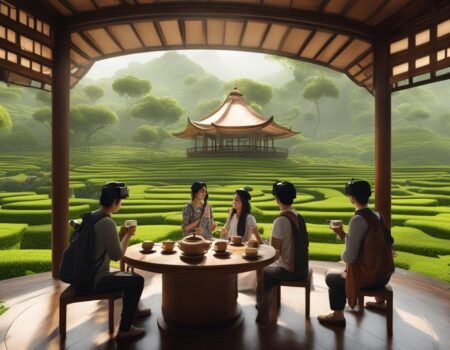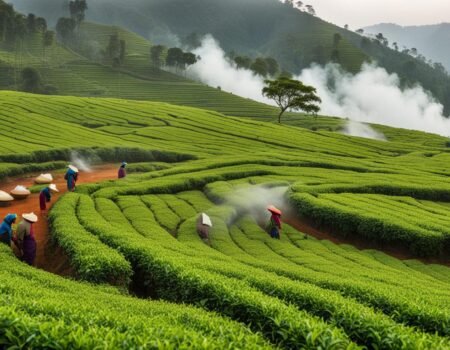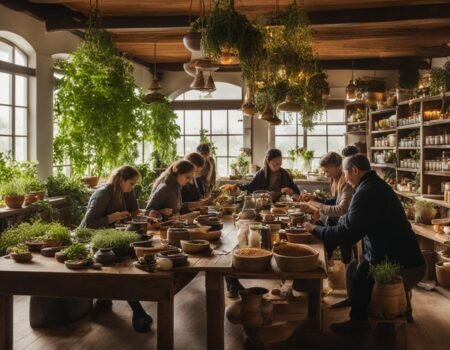
Exploring Traditional Tea Cultures in China, India, and Sri Lanka
Tea is more than just a beverage; it is an integral part of the cultural fabric in China, India, and Sri Lanka. The rich history, unique rituals, and diverse flavors of tea in these countries have been cherished and passed down through generations. In this article, we invite you to embark on a journey with us as we delve into the fascinating world of traditional tea cultures in China, India, and Sri Lanka.
Key Takeaways:
- Traditional tea cultures in China, India, and Sri Lanka have deep historical roots and significant cultural importance.
- Each country has its unique tea traditions, ceremonies, and flavors that have been passed down through generations.
- Tea tourism offers an opportunity to explore tea gardens, learn about tea production, and participate in traditional tea ceremonies.
- Tea’s global influence goes beyond the borders of these three countries, shaping customs and social practices worldwide.
- Through a cup of tea, we can appreciate the diverse flavors and cultural heritage that tea brings to the world.
The Chinese Tea Ceremony: An Elegant Art
The art of Chinese tea ceremony, known as Gongfu Cha, is a cherished tradition that dates back centuries. It is an exquisite ritual that involves the meticulous selection, heating, brewing, and serving of tea. From the choice of tea leaves to the design of the utensils, every aspect of the ceremony is carefully orchestrated to create a harmonious and transcendent experience.
Central to the Chinese tea ceremony is the emphasis on the preparation and presentation of the tea. Traditional Chinese teas are categorized into six types, each with its own unique characteristics and brewing method. The brewing process involves precise measurements of tea leaves, water temperature, and steeping times to achieve the perfect balance of flavors and aromas.
The tea ceremony is not just about the beverage itself; it is an art form that encompasses social interaction and ambiance. Tea masters invest time and effort in selecting special utensils, such as teapots, cups, and trays, which are often ornately decorated. The ceremony is performed in serene and tranquil settings, creating a peaceful atmosphere for participants to savor the tea and engage in meaningful conversations.
“The Chinese tea ceremony is a beautiful blend of art, culture, and mindfulness. It is a moment of tranquility in our fast-paced world, where every sip of tea becomes a meditation. Gongfu Cha allows us to appreciate the subtle nuances of tea and connect with others on a deeper level.”
The Chinese tea ceremony, with its elegance and significance, is an integral part of China’s ancient tea culture. It is a reminder of the value of taking time out of our busy lives to appreciate the simple pleasures and cultivate a sense of mindfulness. Whether enjoyed in a traditional tea house or in the comfort of our own homes, the Chinese tea ceremony invites us to embrace the beauty and tranquility of tea.
Masala Chai: India’s Spiced Tea Tradition
India’s tea culture is deeply rooted in the tradition of Masala Chai, a flavorful and aromatic spiced tea that has captured the hearts of tea enthusiasts worldwide. Masala chai combines the robustness of black tea with a blend of fragrant spices, creating a unique and invigorating beverage that is enjoyed throughout the day.
The history of Masala Chai is intertwined with the ancient practice of Ayurveda, a holistic system of medicine that emphasizes the balance between mind, body, and spirit. Ayurvedic texts recommended the use of spices for their medicinal properties, and over time, the combination of tea and spices became a popular remedy for various ailments.
During the British colonial period, the tea industry in India flourished, and the consumption of tea became widespread. The British influence brought about the addition of milk and sugar to the traditional spiced tea, creating the beloved beverage we know today as Masala Chai.
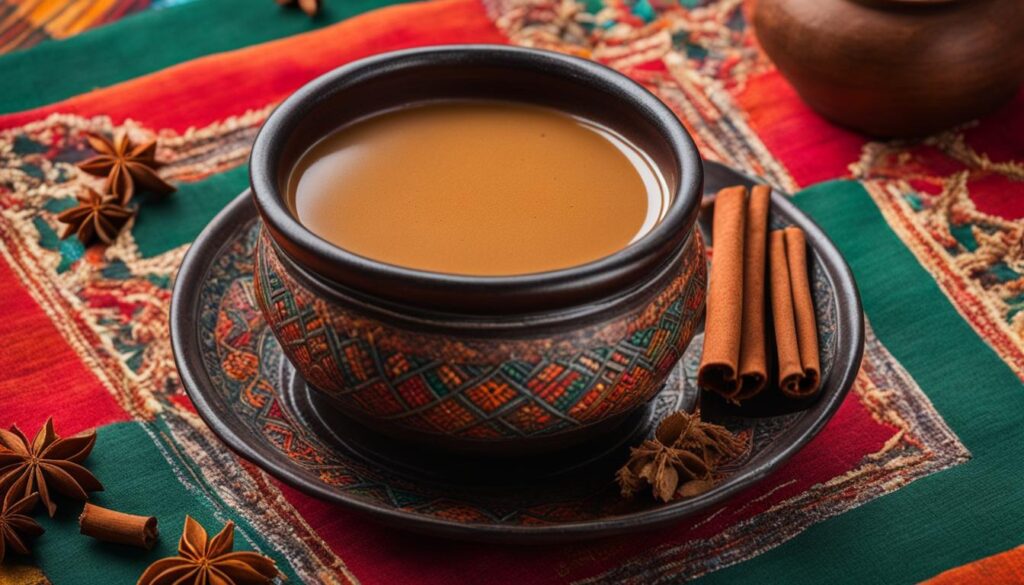
The Ingredients of Masala Chai
The flavors of Masala Chai come from a blend of spices that vary from region to region and from family to family. The most common spices used in Masala Chai include:
- Cinnamon: adds warmth and a hint of sweetness
- Cardamom: provides a refreshing and citrusy flavor
- Ginger: adds a spicy kick and aids digestion
- Cloves: impart a strong and aromatic taste
- Black pepper: adds a subtle heat and enhances the other flavors
These spices are typically combined with loose-leaf black tea and simmered with milk and sweetener to create a rich and flavorful Masala Chai.
A Gesture of Hospitality and Connection
“In India, serving Masala Chai is more than just offering a cup of tea; it is a gesture of hospitality, warmth, and connection.”
In Indian households, Masala Chai is often prepared fresh at home using traditional pots and served to guests as a symbol of welcome and respect. The act of preparing and sharing Masala Chai fosters a sense of community and togetherness, bringing people closer through the shared experience of enjoying this beloved spiced tea.
Whether sipped during morning conversations, shared with friends and family, or offered to guests as a gesture of hospitality, Masala Chai is an integral part of Indian tea culture. Its rich flavors and aromatic spices continue to captivate tea lovers worldwide, inviting them to experience the warmth and cultural heritage that this spiced tea tradition holds.
Sri Lankan Tea Rituals: From Plantations to the Teacup
Sri Lanka, known as the “Teardrop of India,” is renowned for its picturesque tea plantations and the production of Ceylon tea, one of the world’s most prestigious tea varieties. The tea rituals in Sri Lanka go beyond the mere preparation and consumption of tea; they embody the essence of Sri Lankan hospitality and warmth. Serving tea has become a gesture of welcome and respect to guests, making the tea experience an integral part of Sri Lankan culture.
One of the must-visit destinations in Sri Lanka for tea enthusiasts is Nuwara Eliya, a city known for its lush tea plantations and the breathtaking Lipton Seat viewpoint. Here, visitors can witness the fascinating process of tea cultivation, from the meticulously plucked tea leaves to the skillful tea processing techniques that create the unique flavors of Ceylon tea.
Tea rituals in Sri Lanka are not just about the tea; they are about creating connections and fostering a sense of community. It is not uncommon for Sri Lankans to invite guests into their homes for a cup of tea, where the conversation flows as freely as the tea itself. The act of serving tea is a way of showing respect and building relationships, reflecting the values of Sri Lankan culture.
Whether you are exploring the tea plantations or sipping a cup of tea at a local teahouse, the Sri Lankan tea rituals offer a unique and immersive experience. It is an opportunity to delve into the history, culture, and hospitality of Sri Lanka while indulging in the rich flavors and aromas of Ceylon tea.
The Lipton Seat Experience
For a truly unforgettable tea experience in Sri Lanka, a visit to the Lipton Seat is a must. Located in the heart of Haputale, the Lipton Seat offers panoramic views of the tea-covered hills and valleys below. It was named after Sir Thomas Lipton, the famous Scottish tea magnate who played a significant role in establishing the tea industry in Sri Lanka.
“Tea is not just a beverage; it is a way of life in Sri Lanka. The Sri Lankan tea rituals are a testament to the country’s rich history, warm hospitality, and deep-rooted cultural traditions. From the tea plantations to the teacup, every sip of Ceylon tea tells a story, inviting you to experience the beauty and flavors of this enchanting land.”
| Tea Rituals | Location |
|---|---|
| Traditional Tea Ceremony | Nuwara Eliya |
| Tea Tasting Experience | Kandy |
| Tea Garden Visit | Haputale |
| Tea Factory Tour | Galle |
The Evolution of Tea in China, India, and Sri Lanka
Tea drinking has a long and fascinating history in China, India, and Sri Lanka, with each country having its unique tea culture. Over time, tea consumption has evolved, blending tradition with modern influences. Let’s explore how tea has transformed in these three countries, embracing both the traditional and the contemporary.
In China, tea has been consumed for thousands of years and holds a deep cultural significance. The traditional Chinese tea ceremony, Gongfu Cha, continues to be practiced, emphasizing the art of tea brewing and serving. However, modern Chinese tea culture has also seen innovations such as the popularization of bubble tea, a unique concoction of tea, milk, and tapioca pearls. This fusion of tradition and modernity showcases the adaptability and creativity of Chinese tea culture.
In India, tea has a rich history influenced by Ayurvedic practices and British colonialism. Masala Chai, a spiced tea blend, is a beloved beverage that symbolizes the warmth and hospitality of Indian culture. While traditional tea rituals are still cherished, India has also embraced modern variations like iced chai and ready-to-drink packaged teas. This blend of old and new demonstrates the versatility of Indian tea culture and its ability to cater to evolving preferences.
Sri Lanka, known for its scenic tea gardens and production of Ceylon tea, has a long-standing tradition of tea rituals. The experience of sipping tea in Sri Lanka goes beyond taste; it encompasses the country’s spirit of hospitality. As tea tourism gains popularity, visitors can immerse themselves in the beauty of tea gardens and learn about the history and production processes. This merging of tourism and tea culture showcases how Sri Lanka is preserving its tea heritage while adapting to modern demands.
The Evolution of Tea Consumption
Table: Traditional and Modern Tea Consumption
| China | India | Sri Lanka | |
|---|---|---|---|
| Traditional | Gongfu Cha | Masala Chai | Tea rituals and hospitality |
| Modern | Bubble tea | Iced chai | Tea tourism and experiential consumption |
Tea is not only a beverage but a cultural symbol in China, India, and Sri Lanka. As tea drinking has evolved, the traditions have remained rooted, honoring the heritage of each country’s tea culture. The fusion of traditional and modern tea consumption allows us to appreciate the past while embracing the future of tea.
Tea continues to be a beloved drink that transcends borders, connecting people through its universal appeal. As we explore the evolution of tea in China, India, and Sri Lanka, we gain insight into the rich cultural heritage and adaptability of this ancient beverage.
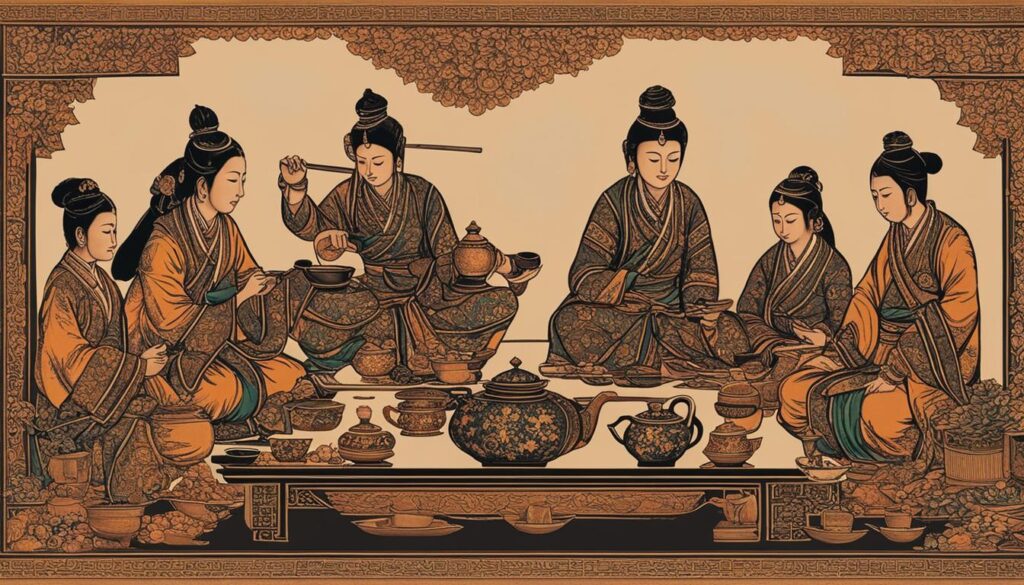
Tea Tourism: Exploring Tea Gardens and Museums
Tea tourism is a blossoming trend that allows travelers to dive deep into the fascinating world of tea. From picturesque tea gardens to enlightening tea museums, there are endless opportunities to explore the history, cultivation, and cultural significance of this beloved beverage. Whether you’re an avid tea enthusiast or simply curious about the traditions surrounding tea, tea tourism offers a unique and immersive experience that combines education, relaxation, and exploration.
One of the highlights of tea tourism is the chance to visit tea plantations and gardens, where the journey from leaf to teacup comes to life. These serene and lush landscapes provide a tranquil setting for learning about tea cultivation and processing. Imagine strolling through the rolling hills of a tea plantation, inhaling the fragrant aromas of freshly plucked tea leaves, and witnessing the meticulous craftsmanship that goes into producing each cup of tea. It’s an opportunity to connect with nature, gain insights into the labor-intensive tea-making process, and appreciate the origins of your favorite brew.
| Destination | Tea Garden Highlights |
|---|---|
| China | Longjing Tea Plantation – Famous for its renowned Dragon Well tea Guilin Tea Farms – Surrounded by stunning limestone karsts |
| Sri Lanka | Nuwara Eliya – Home to picturesque tea gardens and the iconic Lipton Seat viewpoint Talawakelle Tea Estates – Explore the vast tea plantations and learn about Ceylon tea |
Tea museums are another fascinating aspect of tea tourism. These cultural institutions showcase the heritage, craftsmanship, and global impact of tea. Through interactive exhibits, historical artifacts, and informative displays, tea museums provide a comprehensive understanding of tea’s cultural significance. They offer a journey through time, from the ancient origins of tea to its modern-day cultural adaptations. One notable example is the China National Tea Museum in Hangzhou, where visitors can explore the evolution of tea in China and witness firsthand the country’s deep-rooted tea culture.
Tea tourism is a gateway to discovering the diverse flavors, history, and traditions associated with tea. Whether you’re sipping a cup of fragrant jasmine tea in a Chinese tea garden or marveling at the panoramic views of a Sri Lankan tea plantation, each experience adds depth to your understanding and appreciation of tea. So pack your bags, embark on a tea-centric adventure, and let the world of tea enchant and captivate your senses.
Tea’s Global Influence and Cultural Significance
Tea is more than just a beverage; it holds great cultural significance across continents. From the ancient tea ceremonies of China to the vibrant tea traditions of Morocco and Japan, tea has shaped customs, social practices, and gatherings around the world. Its global popularity is a testament to its ability to bring people together, symbolizing hospitality, respect, and connection.
The diverse tea traditions across continents showcase the unique ways in which tea is embraced and celebrated. In China, the Gongfu Cha ceremony exemplifies the elegance and artistry of tea preparation and serving. It is a time-honored ritual that demands careful attention to every detail, from the selection of tea leaves to the temperature of the water. This ceremony not only pays homage to China’s ancient tea culture but also fosters a deep sense of mindfulness and tranquility.
Similarly, Moroccan mint tea holds a prominent place in North African culture. The traditional tea ceremony in Morocco involves a meticulous pouring technique from a beautifully adorned teapot to small glasses. This ceremony symbolizes hospitality and is considered an act of welcoming and bonding. The sweet, aromatic infusion of green tea, fresh mint leaves, and sugar creates a sensory experience that reflects the warmth and generosity of Moroccan culture.
Tea Cultures Conclusion
In conclusion, the diverse tea cultures of China, India, and Sri Lanka have captivated tea enthusiasts worldwide. From the elegant Chinese tea ceremony to the spiced tradition of masala chai in India and the warm hospitality of Sri Lankan tea rituals, each culture offers a unique and authentic tea experience.
As we explored the evolution of tea in these countries, we witnessed the harmonious blend of tradition and modernity. Despite the emergence of new tea trends like bubble tea and iced chai, the cultural heritage of traditional tea practices remains deeply ingrained in the daily lives and social customs of these nations.
Tea tourism has allowed globetrotters to immerse themselves in the captivating world of tea. From visiting tea plantations in China and Sri Lanka to exploring tea museums, travelers have the opportunity to witness firsthand the beauty and significance of tea in these regions.
Tea’s global influence is undeniable, with different countries embracing their unique tea traditions that reflect their cultural values. Tea brings people together, symbolizing hospitality, respect, and connection across continents. So let’s raise our cups and continue to appreciate the diverse flavors and cultural heritage that tea brings to the world.
FAQ
What is the Chinese tea ceremony?
The Chinese tea ceremony, also known as Gongfu Cha, is a centuries-old ritual that involves the careful selection, heating, brewing, and serving of tea. It emphasizes social interaction and ambiance, with tea masters performing the ritual in tranquil settings.
What is Masala Chai?
Masala Chai is a popular spiced tea in India that blends black tea with aromatic spices like cinnamon, cardamom, ginger, cloves, and black pepper. It has a rich history rooted in ancient Ayurvedic texts and is often made at home and served as a gesture of hospitality and connection.
What is Sri Lankan tea known for?
Sri Lanka is renowned for its tea plantations and the production of Ceylon tea, one of the world’s most prestigious tea varieties. Tea rituals in Sri Lanka go beyond the preparation and consumption of tea; they encompass the hospitality and warmth of the Sri Lankan people.
How has tea consumption evolved in China, India, and Sri Lanka?
Traditional tea ceremonies and rituals still hold importance in these countries, but modern society has brought about new ways of consuming tea, such as bubble tea in China and iced chai in India. Despite these changes, the value of traditional tea practices remains deeply ingrained in the daily lives and social customs of people in these countries.
Can I visit tea gardens and museums related to tea?
Yes, tea tourism is on the rise, allowing travelers to immerse themselves in the world of tea. In China, you can visit tea plantations like Longjing and Guilin, while in Sri Lanka, you can explore tea gardens in Nuwara Eliya. There are also tea museums, such as the China National Tea Museum in Hangzhou, where you can learn about tea’s cultural significance and history.
How has tea influenced cultures beyond China, India, and Sri Lanka?
Tea has played a significant role in shaping the customs and social practices of societies around the world. From Moroccan mint tea rituals to Japanese matcha ceremonies, different countries have their unique tea traditions that reflect their cultural values. Tea brings people together, symbolizing hospitality, respect, and connection across continents.
Source Links
- https://www.theculturedcup.com/blogs/blogs/exploring-world-tea-cultures-and-traditions
- https://www.secret-retreats.com/blog/art-architecture/sipping-through-time-an-insight-into-the-art-and-culture-of-tea-drinking-in-asia.html
- https://www.myluxurytravel.fr/en/blog/srilanka-china-must-have-route-of-the-traveling-itinerant/



